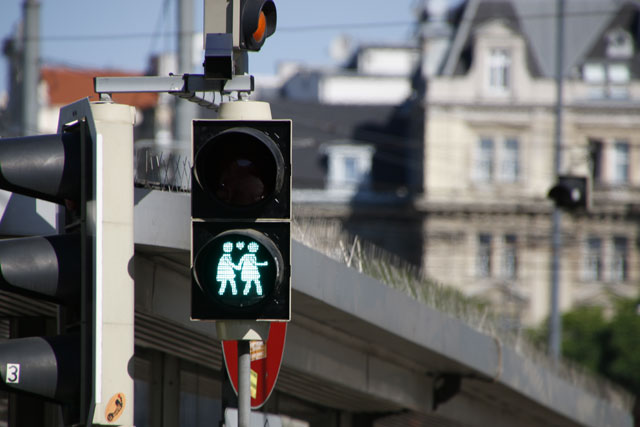We all know how annoying it is as a pedestrian when you want to cross the road and there are no cars or cyclists far and wide – and yet the crossing light for pedestrians simply will not switch to green. In Vienna, this scenario will soon be a thing of the past. TU Graz and Municipal Dept. 33 (Public Lighting) have jointly developed a system that recognises when there are pedestrians wishing to cross.
The smart traffic lights are equipped with more than simple motion sensors. The new system uses camera detectors mounted four metres above the ground to detect pedestrians approaching within an eight-metre radius of the traffic lights. Based on their direction of movement, the software algorithm predicts whether or not they wish to cross and transmits these data to the traffic light control system. Once the pedestrians reach the crossing, the signal then immediately switches to green. As TU Graz Vice-Rector for Research Horst Bischof emphasises, there is no need for concern about data protection and privacy: the system works offline, so the data remain inside the camera box and cannot be read externally. The smart traffic lights are already in operation at the following junctions:
- 4th district, Favoritenstraße – Taubstummengasse
- 6th district, Magdalenenstraße – Kaunitzgasse
- 9th district, Spittelauer Lände – Gusenbauer Gasse
- 10th district, Wienerbergstraße – Eschenallee
- 12th district, Längenfeldgasse – Karl Löwe Gasse
Interconnected traffic lights
The next step beyond recognising pedestrians is to make the traffic light system as a whole smarter and more flexible. This is to be done by allowing traffic lights to communicate with one another, so that e.g. unexpected tailbacks caused by accidents or roadworks can be resolved more quickly. Enabling traffic lights to adapt to the actual traffic situation in this way not only improves traffic flow but also reduces emissions. These valuable traffic-related data could also be passed on to smartphones and satnav devices, allowing them to calculate the speed a vehicle needs to move at in order to avoid red lights.
Weather and environmental sensors
In addition, over the next few years Vienna’s traffic lights are to be equipped with around 10,000 weather and environmental sensors. These will monitor air temperature and humidity, e.g. to allow detection of urban heat islands. Sensors to measure nitrogen oxide, sulphur oxide and noise will be added at a later stage. According to Günther Tschabuschnig of the Central Institute for Meteorology and Geodynamics (ZAMG), this will enable data to be captured from “a huge number of sensors and interfaces for machine-to-machine communication”. These environmental data can be processed and analysed for use in practical applications which may not yet even have been thought of today.
Contact
Municipal Department 33 – Public Lighting
E-Mail: post@ma33.wien.gv.at
Website: Municipal Department 33 – Traffic Lights (in German)
This post is also available in: German




